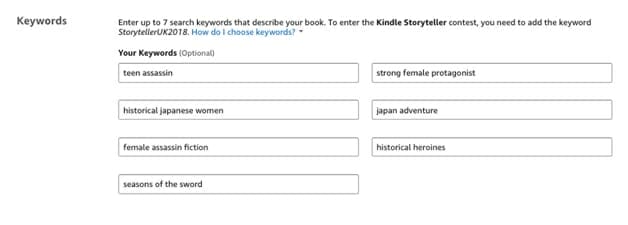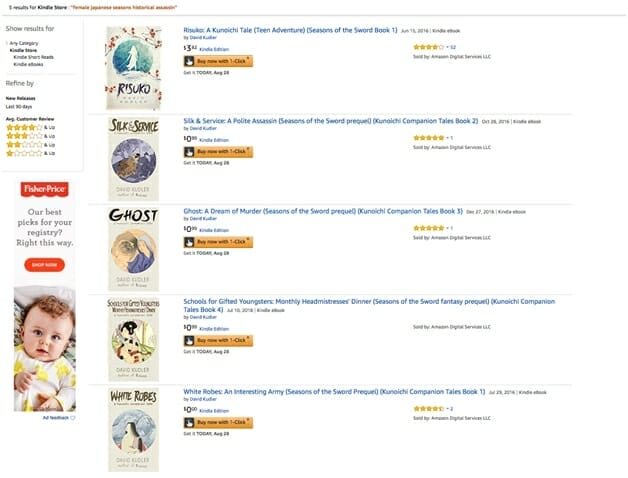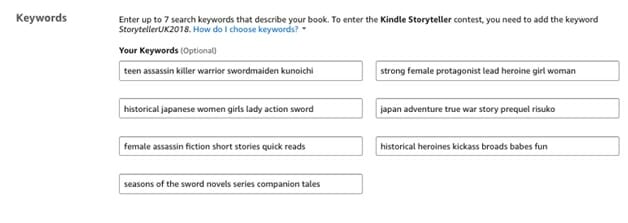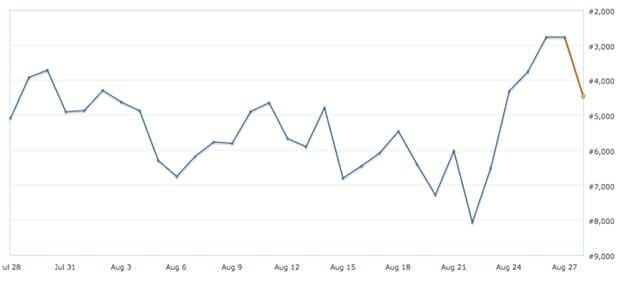By David Kudler
You learn something new every day! In this case, I recently had to revise my understanding of how Amazon handles keywords.
I’ve talked about keywords before; they’re an essential piece of metadata that determines how easy it is for the right reader to find your book. They are in many ways the key to discoverability. It is best to think of them, not as single words, but as search phrases — that is to say, groups of words that your ideal reader is likely to search for. Put a different way, what question is your ideal reader likely to ask to which your book is the answer?
Since I started helping others publish their ebooks in 2010, my advice has been to look for natural-sounding phrases of two to five words that returned between two hundred and a thousand titles on an Amazon search, with a high probability of being able to reach the first page of search results.[i]
The “natural-sounding phrases of two to five words” bit was very important, since (particularly on Amazon’s KDP) the phrases you put in on the back end seemed to have to be either perfect or very close matches to the actual searches for your ebook to show up in results. I tested this several times over the years, and it seemed to have consistently held true.
Here’s an example of the keywords for one of my titles, based on those criteria:

(Those are for my ebook White Robes, which I’ve used as an example in many of my ebook posts.)
Recently, however, I was talking with another indie speculative fiction publisher[ii] at the World Science Fiction Convention and she suggested that Amazon’s search methods might have changed. She said that she’d been playing around, and it seemed to her that rather than using the KDP keywords as natural-language phrases,[iii] Amazon’s search engine was simply looking at all of the words she’d entered and returned the most relevant (and best-selling) results.
We tested her hypothesis right there, and what do you know — she seems to have been correct!
Here’s how I tested the theory:
- I took words from several different White Robes keyword boxes (aka fields).
- I made sure that at least a few of them didn’t appear in the ebook’s description or title.[iv]
- I ran a search on those words in the Kindle Store.
The words I used were:
- female
- Japanese
- seasons
- historical
- assassin
Here’s the result:

Every book in my series of YA historical novels and stories showed up — and nothing else. This is a wonderful proof of the concept — and the likelihood that someone searching with those specific words was looking for one of my books was pretty high, so not a surprising result.
Clearly, Amazon was using the individual words I’d entered rather than the whole phrases, as it had always done before.
The consequences of this are huge.
First, it’s no longer necessary to limit yourself to phrases that a potential reader is actually likely to enter.[v] (I’m pretty sure that natural phrases are still given greater weight, but that’s purely a guess.) Since each keyword field in your book’s KDP record can take up to 50 letters (including spaces), it suddenly becomes much more advantageous to add as many relevant words as you can. By increasing the number of words you’ve entered, you’ve literally made your target larger — and easier to hit.[vi] You’ve increased your discoverability, which is the name of the game in book marketing!
Second, since Amazon searches for the occurrence of a word in any keyword field, it makes no sense to repeat any words.[vii] However, since I assume that natural phrases are still going to show up as more relevant, it does seem like a good idea prioritize the most likely ones and keep them together when possible.
Based on what I’d learned, I rewrote the keywords for White Robes, adding additional pertinent words and phrases. Here’s my (very quick) first attempt:

You’ll see that I kept the initial phrases intact — I’d spent some time trying to find them, after all! I then riffed on a number of words that seemed like likely searches that would lead a reader to White Robes — and make them likely to want to purchase it once they’d found it.
My experiment is still in its very early stages. However, here is a graph of the Amazon ranking for White Robes over the past month (found on my Author Central page):

In case you’re wondering, yes, August 22 is the day when I made that change — and did nothing else to boost the title’s sales. We can safely discard the downward slope on the current day — I took the screenshot of this graph in the morning, so it represents less than half a day’s sales, and those largely overnight, when YA historical is not exactly the genre of choice. 😊
In addition, I had run a quick BookBub ad for the title[viii] on July 27 — the effect of which slowly wore off, leading to the slow downward trend in the rankings from July 28 to August 22. Note that by increasing the number of keywords, I had had a greater impact than a paid ad, at no cost.
I think we can comfortably say that expanding the keywords helped sales — and at the very least did not hurt.
So it seems that the path forward for entering keywords on KDP is clear:
- Use the whole of each keyword field (all 50 characters)[ix]
- Continue to experiment, seeing which kinds of keywords increase or decrease your discoverability (as reflected in your sales)
- Rinse
- Repeat
Let me know your results!
[i] There are lots of tricks to trying to make this happen — see my earlier article for some — and you can also use software tools like KDSpy and KDP Rocket. I am not affiliated with either, but have used both, with generally positive results. Even with the change in Amazon policy discussed in this article, they remain helpful tools in researching good keywords. (If you have a Google AdWords account, the keyword research tools there are also useful — though they don’t specifically focus on the Kindle Store.)
[ii] And I misplaced your card — email me or comment here if you read this!
[iii] As when you put quotes around a search on Google.
[iv] So it’s important to remember that the first places Amazon will look for a match to a customer’s search are the title and subtitle, the author’s name (!), and the description — and only then will it check the keywords. Avoid keyword stuffing — that is, just randomly dumping in words you’d like to show up in searches for. However, it is a good idea to include relevant words in ALL of your metadata, not just the keywords! I often have a parenthetical line at the bottom of the title’s description that includes highly relevant genre/sub-genre/style keywords.
[v] I’m pretty sure that this has always been true for those retailers and aggregators — outside of Amazon, obviously — that allow you to enter keywords and not just categories.
[vi] Do your best to stick to truly relevant words — it does no good for your book to show up in a search if it’s not actually a book someone doing that search would want to buy.
[vii] And since Amazon does seem to check for misspellings and (to a certain extent) analogues, this is even more true. Don’t worry about putting prequel, pre-quel, and prequel as separate entries!
[viii] White Robes is my loss leader for this series — by pushing it (and keeping the price low or free), I’m in effect selling the rest of the titles in the series.
[ix] You were using all seven keyword fields, right?
Photo: BigStockPhoto


